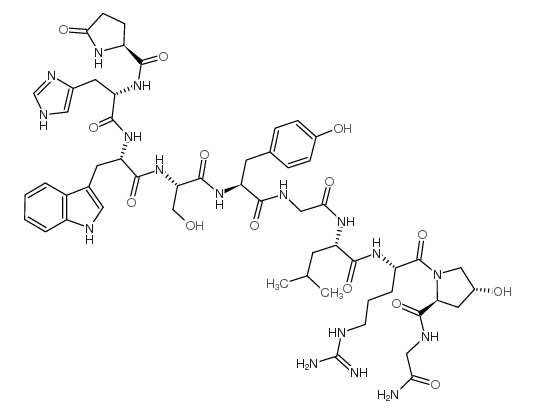Precursor and deaminated forms of both luteinizing hormone-releasing hormone (LHRH) and (hydroxyproline9)LHRH are present in the rat hypothalamus.
J P Gautron, E Pattou, C Kordon
Index: Biochem. Biophys. Res. Commun. 189(3) , 1368-73, (1992)
Full Text: HTML
Abstract
A naturally occurring analog of the decapeptide luteinizing hormone-releasing hormone ([Hyp9]LHRH) has been described previously in the hypothalamus of several mammals. It derives from post-translational hydroxylation of the LHRH proline9 residue. In the present work, intermediate LHRH precursors exhibiting both Pro9 or Hyp9 residues in the LHRH sequence were characterized in the rat hypothalamus. Hydroxylation of the Pro9 residue can thus be assumed to occur at an early stage of post-translational maturation. Deaminated, free acid forms of both native decapeptides were also detected. They correspond most likely to catabolites from incompletely processed precursors.
Related Compounds
| Structure | Name/CAS No. | Molecular Formula | Articles |
|---|---|---|---|
 |
pglu-his-trp-ser-tyr-gly-leu-arg-hyp-gly-nh2
CAS:67019-13-0 |
C55H75N17O14 |
|
Luteinizing hormone-releasing hormone (LHRH)- and (hydroxypr...
1992-05-01 [Endocrinology 130(5) , 2871-6, (1992)] |
|
A second endogenous molecular form of mammalian hypothalamic...
1992-05-01 [Mol. Cell. Endocrinol. 85(1-2) , 99-107, (1992)] |
|
Characterization of [hydroxyproline9]luteinizing hormone-rel...
1995-04-28 [Mol. Cell. Endocrinol. 110(1-2) , 161-73, (1995)] |
|
Preferential distribution of C-terminal fragments of [hydrox...
1993-08-01 [Neuroendocrinology 58(2) , 240-50, (1993)] |
|
In vitro secretion of gonadotropin-releasing hormone (GnRH) ...
1998-10-01 [Neuroendocrinology 68(4) , 281-92, (1998)] |